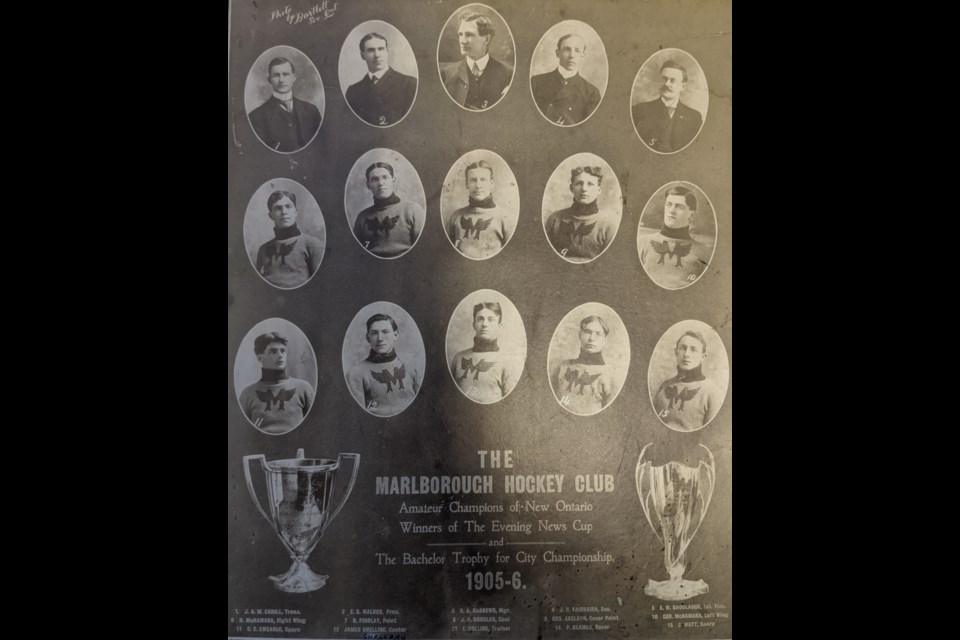Hockey history was made 115 years ago today when the first professional hockey game was played in the Mutual Street Rink (not to be confused with the Mutual Street Arena which would be built six years afterward) in Toronto.
Dec. 28, 1906 saw the host Toronto Professional Hockey Club welcome a team from the International Hockey League. The IHL was comprised that year of five clubs, notably the Calumet Miners, Michigan Soo Indians, Houghton-Portage Lakes, Pittsburgh Professionals and the lone Canadian club, known variously as the Soo Marlboros, the Canadian Soo or the Soo Algonquins. It would be the Canadian Soo club who would oppose the Toronto team.
The front page of the Dec. 27 Sault Star announced that the results of the Christmas Day evening game between the locals and Barrie was not a contest. The headline understated the score, reporting that the “Soo Canadians trims Barrie 12 goals to 4.” The bold print went on to announce that the local seven would play in Toronto the next night.
A ticket to the game that night was raised from the usual fifty cents for reserved seats in the first three rows of Section B and the gallery to an astounding seventy-five cents. Moreover, the news reports were that such would be the prices going forward. That didn’t keep the crowds away, for 1,500 fans filled the rink by the 8:15 p.m. game time. All those fans jammed into the building brought the little heat there was into the unheated natural ice surface.
The game result wasn’t even close, for when the time keeper signalled the end of the second half hour period of play, it was Soo 7 - Toronto 0. It should be said that reports of the game say the score was only 2-0 at the end of the first 30 minute half of the game. In this age of the game, teams fielded seven men on the ice for two 30 minute periods without substitutions, save for serious injuries.
The seven man squad for the Canadian Soo club was comprised of Lehman in goal, Brown on point, McRobie at cover point, Bill Taylor as rover, Walsh at centre, Schaeffer on left wing and Wilson on right wing. The point and cover point positions are what we know as defence in the modern game with the cover point being more of a rushing defenceman. The rover covered the area between the forwards and the defence. Bill Taylor was the league’s leading scorer with 46 goals and 64 points in the 24 game season.
It would be four years and a new National Hockey Association league before the 60 minutes of hockey was divided into three equal periods. This concept was devised and implemented by two of hockey’s most prolific pioneers, Lester and Frank Patrick. It would benefit the players by giving them two rest periods and it would benefit the rink owners by giving the fans a second opportunity to visit the concession stands.
In a related historical note, on Jan. 3, 1907, just a week after this inaugural professional game, centre Marty Walsh would break his leg in a game against Calumet. His position would be filled in the Soo lineup by 19 year old Edouard 'Newsy' Lalonde. When his hockey career was finished, Lalonde would be considered the greatest player of the first half of the 20th century. He is still the NHL’s third highest points per game scorer behind Gretzky and Lemieux.
Interestingly enough, the Soo team colours in those days were black, red and white, which have endured in whole or in part through the generations of hockey clubs whether they were playing in Wrigley’s Arena (which doubled as the curling rink) before its demise to fire in 1910, the new Gouin Street Arena (which also hosted curlers and where I first learned to curl), built adjacent to the old site, the Sault Memorial Gardens built following the Second World War to honour the city’s losses in that conflict or the GFL Memorial Gardens of today. It echos of the time when the Thunderbirds were the home club sporting the black, red and white in their time in the EPHL as a Chicago Black Hawks farm club. Over the recent years, the Soo Greyhounds have sported a black third jersey.
The IHL folded at the end of its third season of operation in 1907 and the Soo went on to play in other hockey leagues, but for one shining night in December 1906, the boys from the north made the citizens of Hogtown pay attention to how hockey should be played.
Phil Miller is a retired United Church minister and a noted local military historian. His most recent work has been the final edit of Northern Soldiers: The History of the 49th Field Artillery Regiment, RCA which is presently in pre-publication order status. He was recently invited to write for the National Wall of Remembrance Association Journal. His article on Indigenous Warriors of Sault Ste. Marie was the journal lead story.
